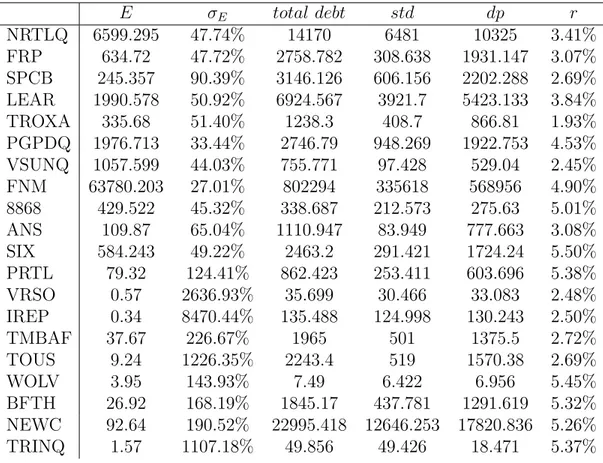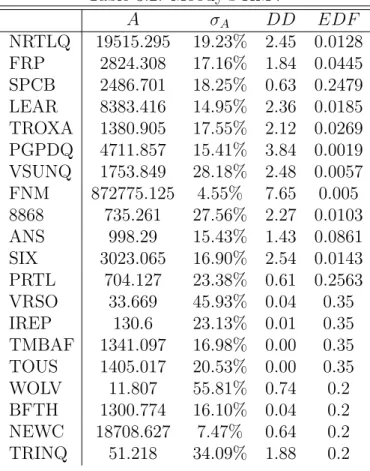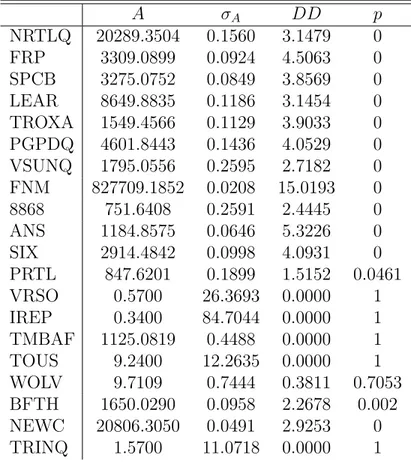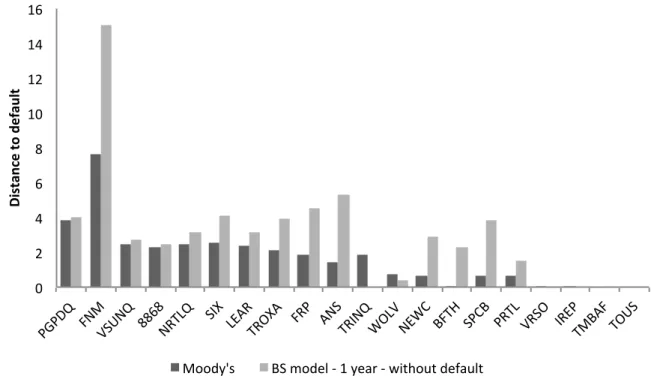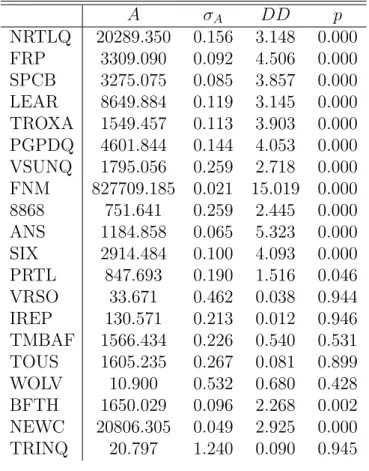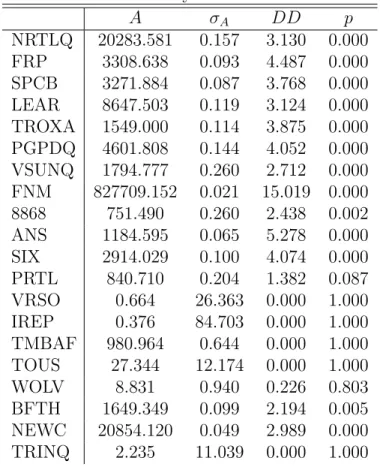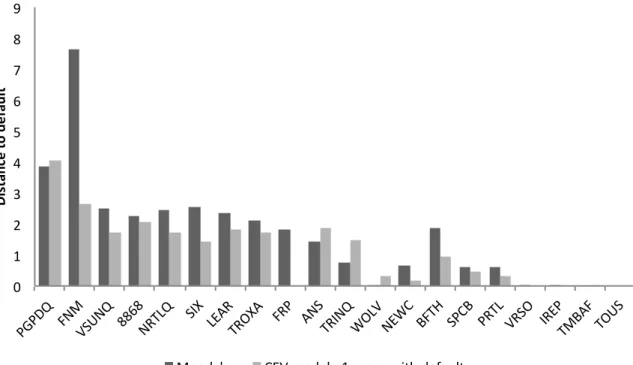Instituto Superior de Ciˆencias do Trabalho e da Empresa Faculdade de Ciˆencias da Universidade de Lisboa
Departamento de Finan¸cas do ISCTE Departamento de Matem´atica da FCUL
ALTERNATIVE STRUCTURAL MODELS TO APPROXIMATE MOODY’S KMV DISTANCE TO DEFAULT
Guilherme Ferreira da Costa
A Dissertation presented in partial fulfillment of the Requirements for the Degree of
Instituto Superior de Ciˆencias do Trabalho e da Empresa Faculdade de Ciˆencias da Universidade de Lisboa
Departamento de Finan¸cas do ISCTE Departamento de Matem´atica da FCUL
ALTERNATIVE STRUCTURAL MODELS TO APPROXIMATE MOODY’S KMV DISTANCE TO DEFAULT
Guilherme Ferreira da Costa
A Dissertation presented in partial fulfillment of the Requirements for the Degree of
Master in Financial Mathematics
Dissertation supervised by Professor Doutor Jo˜ao Pedro Pereira
Resumo
Esta tese compara o uso de diferentes modelos estruturais para estima¸c˜ao dos activos de uma empresa e da da volatilidade dos mesmos, de modo a cal-cular o correspondente valor da Distance to Default, tal como definido pela Moody’s KMV. A abordagem utilizada consiste em implementar a estima¸c˜ao de m´etodos baseados no modelo de Black-Scholes e no modelo CEV. Estes m´etodos s˜ao seguidamente utilizados para determinar os valores da Distance to Default para uma amostra de empresas, de modo a encontrar o m´etodo que melhor aproxima os valores da Moody’s KMV. Alguns dos resultados obtidos foram melhores que os do modelo padr˜ao, o modelo Black-Scholes. O uso de um modelo baseado em interpretar o valor de mercado da empresa como uma op¸c˜ao do tipo Down and Out Call sobre os activos da empresa, os quais se determinou seguirem o modelo CEV Square Root, e em postular directamente uma rela¸c˜ao funcional entre a volatilidade dos activos da em-presa e a volatilidade do valor da emem-presa em mercado, mostrou resultados substancialmente melhores que os restantes modelos.
Palavras-Chave: Moody’s KMV, Distance to Default, Modelo Black-Sholes, Modelo CEV.
Abstract
This thesis compares the use of different structural models in order to esti-mate a firm’s assets and asset’s volatility values and compute the correspond-ing Distance to Default value as defined by Moody’s KMV. The approach used consists in implementing estimation methods based on the Black-Scholes Model and the Constant Elasticity of Variance Model. These methods are then applied to determine the Distance to Default values from a sample of firms, in search for the method that better approximates Moody’s KMV val-ues. Some of the results obtained were better than the benchmark model, the Black-Scholes model. The use of a model based on interpreting equity as one-year Down and Out Call Option on the firm’s assets who were determined to follow a CEV Square Model and on postulating directly a functional relation between the firm’s asset’s volatility and equity volatility, showed substan-tially better results than the remaining models.
Key-words: Moody’s KMV, Distance to Default, Black-Sholes Model, CEV Model.
Acknowledgments
I am deeply indebted to my supervisor Jo˜ao Pedro Pereira for its constant support during the writing of this thesis.
I would like to thank professor Jo˜ao Pedro Nunes for the time spared helping me with questions regarding the CEV model.
I am also very grateful to my uncle Ricardo Severino and aunt Joana Soares and to my cousin Em´ılia Ata´ıde for their comments and suggestions.
Contents
1 Moody’s KMV Expected Default Frequency and Distance to
Default 3
1.1 Estimating the firm’s assets value and volatility . . . 3
1.2 Calculating the distance to default . . . 4
1.3 Mapping the Distance to Default to the probability of default 4 2 Theoretical Models 5 2.1 General Considerations . . . 5
2.2 Black-Scholes Model . . . 6
2.2.1 Black-Scholes Model - 1 year - without default . . . 6
2.2.2 Black-Scholes Model - 1 year - with default . . . 7
2.3 CEV Square Root Model . . . 9
2.3.1 CEV Model - 1 year - without default . . . 9
2.3.2 CEV Model - 1 year - with default . . . 10
2.3.3 CEV Model - 10 years - with default . . . 11
3 Numerical Results 13 3.1 Sample and Moody’s KMV results . . . 13
3.2 Black-Scholes Model . . . 15
3.2.1 Black-Scholes Model - 1 year - without default . . . 15
3.2.2 Black-Scholes Model - 1 year - with default . . . 17
3.3 CEV Model . . . 19
3.3.1 CEV Model - 1 year - without default . . . 19
3.3.2 CEV Model - 1 year - with default . . . 21
3.3.3 CEV Model - 10 year - with default . . . 25
3.4 Comparison of the Models . . . 27
A Auxiliary Results 30 A.1 Derivation of Black-Scholes δ . . . 30
B Auxiliary Tables 31
B.1 Firms used in the sample . . . 31
C Monte Carlo Methods 33
C.1 ECEV(A, X, dp, r, τ ) . . . 33
Introduction
Structural models have been in use for years as a basis for credit risk and credit pricing models 1.
Moody’s KMV (MKVM) implements a modified structural model called the Vasicek-Kealhofer model, which allows for the estimation of the assets and asset’s volatility of a publicly traded firm. These estimates are used by MKVM to compute a “distance to default” (DD) value for which it deter-mines an empirical distribution to generate the Expected Default Frequency (EDF) measure 2.
Due to commercial reasons, MKMV method is not fully disclosed. More-over, for many investors in need of estimating default probabilities or merely comparing the risk of investing in different firms3, replicating MKVM
method-ology would be an impractically complex and time-consuming task and would require the use of MKVM proprietary defaults database.
This thesis addresses the problem of estimating MKMV DD using struc-tural models that result in methods different from the MKMV methodology. It proposes alternative structural models and analyses them in terms of: (a) their capacity for approximating DD values as computed by MKVM; (b) their computation time; (c) their ability to approximate MKVM EDF values.
The thesis is organized as follows. Chapter 1 describes MKMV general framework for estimating default probabilities. It also contains MKVM DD definition, how to compute it and how to calculate its corresponding EDF measure.
Chapter 2 exposes the proposed structural models from a theoretical point
1See, for example, the description of the Merton and Vasicek-Kealhofer models present
in Arora et al. [2005].
2This is a commercially available estimate of a firm’s one-year default probability. 3Note that it is theoretically possible to compare firms in terms of their default risk
of view. It describes in detail each of the model’s assumptions and motiva-tions and derives the corresponding formulas that allow us to estimate the assets and asset’s volatility values needed to compute a firm’s DD.
In Chapter 3 we test the models introduced in the previous chapter, using a sample obtained from MKMV of DD and EDF measures for different firms. We measure the difference between MKVM DD and EDF values and our models values for each of the firms in the sample. We then compare our models based on these results and on their computation time.
Chapter 1
Moody’s KMV Expected
Default Frequency and
Distance to Default
Moody’s KMV EDF (Expected Default Frequency) credit risk measures are forward-looking default probabilities estimates for public (and private) firms. Each EDF measure is determined in three steps:
1. Estimate the firm’s assets value and volatility; 2. Calculate the Distance to Default;
3. Map the Distance to Default to the probability of default.
1.1
Estimating the firm’s assets value and
volatil-ity
In this step, for a publicly traded firm, asset value (A) and asset volatility (σA) are estimated from the market value of equity and book value of
lia-bilities. In general, this can be achieved by choosing a structural model and using an options pricing based approach, which recognizes equity as a call option on the underlying assets of the firm 1. For this purpose, MKVM uses
a version of the Vasicek-Kealhofer model, whose original formulation can be found in Vasicek [1984].
1.2
Calculating the distance to default
Having estimated A and σA, MKVM computes the Distance to Default
trough the following formula 2:
DD = A− dp AσA
, where dp denotes the default point.
The default point is an estimate of the value for which if the firm’s assets value falls bellow, the firm will default.
It is important to stress that this is an estimate and that it does not coincide with the value of the firm’s liabilities. As stated by MVMV [Crosbie and Bohn, 2003, p. 7], “in general firms do not default when their asset value reaches the book value of their total liabilities. (...) The asset value the firm will default, generally lies somewhere between total liabilities and current, or short-term liabilities”.
1.3
Mapping the Distance to Default to the
probability of default
Usually, the estimates described in Section 1.2 would allow us to compute a model implied default probability, either analytically or by using Monte Carlo Methods.
However, in the case of Moody’s KMV use of the Vasiceck-Kealhofer model, default probabilities calculated in this manner “provide little dis-criminatory power” [Crosbie and Bohn, 2003, p. 14-18].
For this reason, EDF measures are computed using the DD empirical distribution. MKVM obtains a relationship between DD and default prob-ability from data on historical default: 3 for each DD value, the company
queries the default history for the proportion of firms with this DD value that defaulted over the following year.
2To be precise, MKVM DD values depend on the time horizon we are considering:
there is a DD value for each time horizon; the formula presented here is a one year DD. See the example from page 32 in Dwyer and Qu [2007].
3MKMV uses a database including over 250,000 company-years of data and over 4,700
incidents of default or bankruptcy; see [Crosbie and Bohn, 2003, p. 14] and [Dwyer and Qu, 2007, p. 22].
Chapter 2
Theoretical Models
2.1
General Considerations
In each section of this chapter, we will follow the methodology described in Section 1.1:
i. Describe equity as a call option on the underlying assets of the firm; ii. Choose a structural model that posits a stochastic process for the value
of the firm’s assets and from which it is possible to derive a valuation formula for the option specified in i.;
iii. Write an equation using the option valuation formula from ii. that relates A and σAwith the firm’s equity (E), the firm’s equity volatility (σE) and
the risk-free interest rate (r); apply Ito’s lemma to the process from ii. or specify a functional relation between σAand σE in order to obtain the
second equation needed to estimate A and σA.
The approach followed was to choose as structural models for step ii. the Black-Scholes model, for being the simplest of the most widely used models in option valuation, and the Constant Elasticity of Variance (CEV) model1.
The resulting empirical distribution of default probabilities as computed by MKMV has much wider tails than the Normal distribution resulting from the use of the Black-Scholes model 2. The CEV Model posits a distribution
1To be precise, we used a particular case of this model called the Constant Elasticity
of Variance Square-Root Model.
for the time t value of the assets that possess wider tails than the correspond-ing Lognormal distribution from the Black-Schols model. For this reason, the CEV model is a natural alternative to the Black-Scholes model. Moreover, the fact that it exhibits the so called leverage effect on volatility (the instan-taneous variance of stock returns being inversely related to the asset price) led us to formulate the hypothesis that this is a more powerful model for the estimation of default probabilities 3.
2.2
Black-Scholes Model
The Black-Scholes model posits that the market value of a firm’s underlying assets (A) follows the following stochastic process:
dA = µAAdt + σAAdz, (2.1)
where σA denotes the annualized volatility of the asset and dz is a standard
Brownian motion.
2.2.1
Black-Scholes Model - 1 year - without default
In this section we assume that:
i. The firm’s assets follow the process described by Equation (2.1); ii. All the firm’s debt is short-term debt with maturity equal to one year; iii. There is no possibility of default occurring during the forthcoming year; iv. In a year from now, it will be indifferent to an investor holding all the firm’s equity or receiving the value of the firm’s assets minus the short-term debt that must be paid.
These assumptions imply that holding equity today is equivalent to holding a call option on the assets of the firm with strike price equal to the short-term debt and maturity equal to one year. Using the Black-Scholes option pricing formula 4, we can therefore write
E = AN (d1)− e−rτstdN (d2), (2.2)
3The existence of this leverage effect on volatility is supported by several empirical
studies: see, for instance, Beckers [1980] and Christie [1982].
where E denotes the equity value observed today in the market, std is the amount of short-term debt the firm owes, r is the risk-free interest rate, N (.) is the standard normal cumulative distribution function, τ = 1 is the time to maturity, d1 = ln (stdA) + (r + σA2 2 ) σA and d2 = d1− σA.
Since E is a function of A and t, we can use Ito’s lemma to conclude that dE =�∂E ∂t + µAA ∂E A + 1 2(σAA) 2∂2E ∂A2 � dt + σAA ∂E ∂Adz. This implies that
dE E = � 1 E ∂E ∂t + µA A E ∂E A + 1 2σ 2 A A2 E ∂2E ∂A2 � dt + σA A E ∂E ∂Adz and so we obtain the relation
σE = A E ∂E ∂AσA= A EN (d1)σA 5. (2.3)
Equity’s volatility σE can be estimated from equity’s historical market values.
Therefore, we can approximate A and σAby solving the system composed of
equations (2.2) and (2.3) E = AN (d1)− e−rτstdN (d2) σE = AEN (d1)σA (2.4)
2.2.2
Black-Scholes Model - 1 year - with default
The assumptions from the previous section can be made more realistic by replacing assumption iii. with:
iii. Default can occur at anytime.
5See appendix A for the derivation of the equality ∂E
Again, equity can be valued (approximately) as a call option with underlying equal to A and strike equal to std, maturing in a year. Assumption iii. implies that the referred option should be a Down and Out Call with lower barrier equal to the dp and zero rebate, accounting for the fact that the firm can default in case At < dp. Using the Black-Scholes option pricing formula for
a Down and Out Call 6 , and noting that max (std, dp) = dp, we get
E = C (A, std, τ )− � dp A �2 C � (dp)2 A , std, τ ) = AN (d1)− e−τrstdN (d2)− � dp A �2� dp2 A N (d3)− e −τrstdN (d 4) � , (2.5) where τ = 1, C(A, X, τ ) denotes the Black Scholes model valuation of a standard call with underling A, strike X and maturity τ ,
d1 = ln ( A std) + τ (r + σ2 A 2 ) 3σA , d2 = d1− σA, d3 = ln [A stddp2 ] + τ (r + σ2A 2 ) 3σA and d4 = d3− σA.
Using Ito’s lemma as in the previous section, we can approximate A and σA by solving the system 7
E = AN (d1)− e−τrstdN (d2)− (dpA) 2 [(dp)A2N (d3)− e−τrstdN (d4)] σE = AE∂E∂AσA 6See Merton [1973]. 7Note that ∂E
2.3
CEV Square Root Model
The Constant Elasticity of Variance (CEV) Square Root model posits that the market value of a firm’s underlying assets follows the following stochastic process:
dA = µAAdt + δA
√
Adz. (2.6)
It follows immediately from the above equation that σA =
δA
√
A. (2.7)
2.3.1
CEV Model - 1 year - without default
The assumptions made in this section are the same as the ones described in Section 2.2.1, except for statement i., which we now replace with
i. The firm’s assets follow the process described in (2.6).
Again, these assumptions imply that holding equity today is equivalent to holding a call option on the assets of the firm with strike price equal to the short-term debt and maturity equal to one year. Using the CEV model option pricing formula 8, we can therefore write
E = AQχ2(4,2x)(2k std)− std e−rτ[1− Qχ2(2,2kX)(2x)], (2.8)
where Q2
χ(a, b) denotes the complementary distribution function of a random
variable that follows a non-central Chi-squared law with a degrees of freedom and no-centrality parameter b, τ = 1 is the time to maturity of the option,
k := 2r δ2 A(erτ − 1) , and x := kAerτ. Applying Ito’s Lemma we can conclude that:
dE =�∂E ∂t + µAA ∂E A + 1 2(δA √ A)2∂ 2E ∂A2 � dt + δA √ A∂E ∂Adz. 8See Cox [1975].
This implies that dE E = � 1 E ∂E ∂t + µA A E ∂E A + 1 2δ 2 A A E ∂2E ∂A2 � dt + δA √ A E ∂E ∂Adz and so we obtain the relation
σE = √ A E ∂E ∂AδA. (2.9)
As in the previous chapter, we can approximate A and δA by solving the
system composed of equations (2.8) and (2.9) E = AQχ2(4,2x)(2k std)− std e−rτ[1− Qχ2(2,2kX)(2x)] σE = √ A E ∂E ∂AδA (2.10)
After approximating A and δA, an estimate of σA can be obtained trough
Equation (2.7).
2.3.2
CEV Model - 1 year - with default
In this section it is assumed that:
i. The firm’s assets follow the process described by Equation (2.6); ii. All the firm’s debt is short-term debt with maturity equal to one year; iii. Default can occur at anytime.
iv. In a year from now, it will be indifferent to an investor holding all the firm’s equity or receiving the value of the firm’s assets minus the short-term debt that must be paid.
Henceforth, ECEV(A, X, dp, r, τ ) denotes the computed value of a
Euro-pean Down and Out Call option with an underlying A following the process described by Equation (2.6), strike X, lower barrier dp, maturity τ = 1, zero rebate and risk-free rate r. This value is computed using a Monte Carlo method, detailed in appendix C.
The use of Monte Carlo Methods for the valuation of E implies that the time required to compute ∂E∂A numerically makes it unfeasible the use of Equation (2.9). Consequently, the approach followed was to postulate directly the functional relation supposed to exist between σA and σE.
vi. Equity also follows a CEV Square Root Model of the type described by Equation (2.8);
vii. δA≈ δE.
Since assumption vi. implies that σE = √δEE and consequently that δE =
σE
√
E, we can approximate δA using assumption vii:
δA≈ δE = σE
√
E. (2.11)
Regarding assumption vii., it is worth noting that it is well known that in general σA < σE 9. What we are assuming, recurring here to Equation
(2.9), is that σA < σE due to the fact that we usually have A > E. We see
no reason to believe the way σA changes with A, is in any aspect, different
from the way σE varies with E.
Since equity can be seen as a Down and Out Call Option with zero rebate, as was done in Section 2.2.2, and using Equation (2.11), we can write
E = ECEV(A, std, dp, r, τ ) δA = σE √ E (2.12)
2.3.3
CEV Model - 10 years - with default
In this section we consider a more realistic picture of a firm’s debt structure by defining two classes of debt: short-term debt and long-term debt.
The assumptions made are the following:
i. The firm’s assets follow the process described by Equation (2.6);
ii. The firm’s debt consists of short-term debt (std), maturing in one year, and long-term debt (ltd), which we assume will mature in ten years; iii. Default can occur at anytime;
iv. In ten years from now, it will be indifferent to an investor holding all the firm’s equity or receiving the value of the firm’s assets minus ltd;
v. Equity follows a CEV Square Root Model of the type described by Equa-tion (2.8);
vi. δA≈ δE.
It is worth noting that the above assumptions imply the following:
a) If somewhere between now and a year from now we have At < dp, our
firms defaults;
b) In a year from now, our firm will have to pay the short-term debt std, implying that A1 will be replaced by A1− std and dp by dp − std;
c) After reaching year one and paying std, we can approximate equity’s value by that of a European Down and Out Call option with underlying (A− dp), strike ltd, lower barrier (dp − std), maturity τ = 9, zero rebate and risk-free rate r.
From statements a), b) and c), it is possible to value equity’s present value using Monte Carlo methods, as described in Appendix C .
Representing these valuation by E = ECEV10(A, std, ltd, dp, r, τ ) we can
then solve, as in the previous section, the following equations: E = ECEV10(A, std, ltd, dp, r, τ ) δA= σE √ E (2.13)
As stated before, after estimating δA, σA can be approximated trough
Chapter 3
Numerical Results
3.1
Sample and Moody’s KMV results
The models described in Chapter one were applied to a sample of 20 firms, whose relevant financial data, as supplied by Moody’s KMV, is summarized below in Table 3.1. E denotes the firm’s equity, σE, its equity volatility, std
the short-term debt, dp the firm’s default-point and r its risk-free rate. Each firm is identified with an abbreviated name. For the firm’s complete name, as well as the date to which the presented data refers to, see appendix B.
All default probabilities presented were computed using Monte Carlo methods, generating for each computation n = 1000 sample paths, each with 120 equally spaced points.
Table 3.1: Sample Data E σE total debt std dp r NRTLQ 6599.295 47.74% 14170 6481 10325 3.41% FRP 634.72 47.72% 2758.782 308.638 1931.147 3.07% SPCB 245.357 90.39% 3146.126 606.156 2202.288 2.69% LEAR 1990.578 50.92% 6924.567 3921.7 5423.133 3.84% TROXA 335.68 51.40% 1238.3 408.7 866.81 1.93% PGPDQ 1976.713 33.44% 2746.79 948.269 1922.753 4.53% VSUNQ 1057.599 44.03% 755.771 97.428 529.04 2.45% FNM 63780.203 27.01% 802294 335618 568956 4.90% 8868 429.522 45.32% 338.687 212.573 275.63 5.01% ANS 109.87 65.04% 1110.947 83.949 777.663 3.08% SIX 584.243 49.22% 2463.2 291.421 1724.24 5.50% PRTL 79.32 124.41% 862.423 253.411 603.696 5.38% VRSO 0.57 2636.93% 35.699 30.466 33.083 2.48% IREP 0.34 8470.44% 135.488 124.998 130.243 2.50% TMBAF 37.67 226.67% 1965 501 1375.5 2.72% TOUS 9.24 1226.35% 2243.4 519 1570.38 2.69% WOLV 3.95 143.93% 7.49 6.422 6.956 5.45% BFTH 26.92 168.19% 1845.17 437.781 1291.619 5.32% NEWC 92.64 190.52% 22995.418 12646.253 17820.836 5.26% TRINQ 1.57 1107.18% 49.856 49.426 18.471 5.37%
Moody’s KMV Model results for this given sample are presented bellow. Table 3.2: Moody’s KMV A σA DD EDF NRTLQ 19515.295 19.23% 2.45 0.0128 FRP 2824.308 17.16% 1.84 0.0445 SPCB 2486.701 18.25% 0.63 0.2479 LEAR 8383.416 14.95% 2.36 0.0185 TROXA 1380.905 17.55% 2.12 0.0269 PGPDQ 4711.857 15.41% 3.84 0.0019 VSUNQ 1753.849 28.18% 2.48 0.0057 FNM 872775.125 4.55% 7.65 0.005 8868 735.261 27.56% 2.27 0.0103 ANS 998.29 15.43% 1.43 0.0861 SIX 3023.065 16.90% 2.54 0.0143 PRTL 704.127 23.38% 0.61 0.2563 VRSO 33.669 45.93% 0.04 0.35 IREP 130.6 23.13% 0.01 0.35 TMBAF 1341.097 16.98% 0.00 0.35 TOUS 1405.017 20.53% 0.00 0.35 WOLV 11.807 55.81% 0.74 0.2 BFTH 1300.774 16.10% 0.04 0.2 NEWC 18708.627 7.47% 0.64 0.2 TRINQ 51.218 34.09% 1.88 0.2
3.2
Black-Scholes Model
3.2.1
Black-Scholes Model - 1 year - without default
Table 3.3: Black-Scholes - 1 year - without default A σA DD p NRTLQ 20289.3504 0.1560 3.1479 0 FRP 3309.0899 0.0924 4.5063 0 SPCB 3275.0752 0.0849 3.8569 0 LEAR 8649.8835 0.1186 3.1454 0 TROXA 1549.4566 0.1129 3.9033 0 PGPDQ 4601.8443 0.1436 4.0529 0 VSUNQ 1795.0556 0.2595 2.7182 0 FNM 827709.1852 0.0208 15.0193 0 8868 751.6408 0.2591 2.4445 0 ANS 1184.8575 0.0646 5.3226 0 SIX 2914.4842 0.0998 4.0931 0 PRTL 847.6201 0.1899 1.5152 0.0461 VRSO 0.5700 26.3693 0.0000 1 IREP 0.3400 84.7044 0.0000 1 TMBAF 1125.0819 0.4488 0.0000 1 TOUS 9.2400 12.2635 0.0000 1 WOLV 9.7109 0.7444 0.3811 0.7053 BFTH 1650.0290 0.0958 2.2678 0.002 NEWC 20806.3050 0.0491 2.9253 0 TRINQ 1.5700 11.0718 0.0000 1
Figure 3.2.1 compares this section model DD results with Moody’s data. Firms are ordered in descending order of DD (as computed by MKMV).
Figure 3.1: Moody’s vs BS-1Y-without default - distance to default
!" #" $" %" &" '!" '#" '$" '%" ()(* +" ,-." /01-+ " &&%&"-234+ " 056" 4782"32968" ,2(" 8-0" 325-+" :94/ " -7:; " <,3=" 0(;< " (234"/209" 527("3.<8, " 391 0" !" #$ %& '()$ *)+ (,% -. $) .>>?@AB" <0"C>?DE"F"'"@DGH"F"IJKL>MK"?DNGMEK""
3.2.2
Black-Scholes Model - 1 year - with default
Table 3.4: Black-Scholes - 1 year - with default A σA DD p NRTLQ 20289.350 0.156 3.148 0.000 FRP 3309.090 0.092 4.506 0.000 SPCB 3275.075 0.085 3.857 0.000 LEAR 8649.884 0.119 3.145 0.000 TROXA 1549.457 0.113 3.903 0.000 PGPDQ 4601.844 0.144 4.053 0.000 VSUNQ 1795.056 0.259 2.718 0.000 FNM 827709.185 0.021 15.019 0.000 8868 751.641 0.259 2.445 0.000 ANS 1184.858 0.065 5.323 0.000 SIX 2914.484 0.100 4.093 0.000 PRTL 847.693 0.190 1.516 0.046 VRSO 33.671 0.462 0.038 0.944 IREP 130.571 0.213 0.012 0.946 TMBAF 1566.434 0.226 0.540 0.531 TOUS 1605.235 0.267 0.081 0.899 WOLV 10.900 0.532 0.680 0.428 BFTH 1650.029 0.096 2.268 0.002 NEWC 20806.305 0.049 2.925 0.000 TRINQ 20.797 1.240 0.090 0.945
Figure 3.2.2 compares this section model DD results with Moody’s data. Firms are ordered in descending order of DD (as computed by MKMV).
Figure 3.2: Moody’s vs BS-1Y-with default - distance to default
!" #" $" %" &" '!" '#" '$" '%" ()(* +" ,-." /01-+ " &&%&"-234+ " 056" 4782"32968" ,2(" 8-0" 325-+" :94/ " -7:; " <,3=" 0(;< " (234"/209" 527("3.<8, " 391 0" !" #$ %& '()$ *)+ (,% -. $) .>>?@AB" <0"C>?DE"F"'"@DGH"F"IJKL"?DMGNEK"
3.3
CEV Model
3.3.1
CEV Model - 1 year - without default
Table 3.5: CEV - 1 year - without default A σA DD p NRTLQ 20283.581 0.157 3.130 0.000 FRP 3308.638 0.093 4.487 0.000 SPCB 3271.884 0.087 3.768 0.000 LEAR 8647.503 0.119 3.124 0.000 TROXA 1549.000 0.114 3.875 0.000 PGPDQ 4601.808 0.144 4.052 0.000 VSUNQ 1794.777 0.260 2.712 0.000 FNM 827709.152 0.021 15.019 0.000 8868 751.490 0.260 2.438 0.002 ANS 1184.595 0.065 5.278 0.000 SIX 2914.029 0.100 4.074 0.000 PRTL 840.710 0.204 1.382 0.087 VRSO 0.664 26.363 0.000 1.000 IREP 0.376 84.703 0.000 1.000 TMBAF 980.964 0.644 0.000 1.000 TOUS 27.344 12.174 0.000 1.000 WOLV 8.831 0.940 0.226 0.803 BFTH 1649.349 0.099 2.194 0.005 NEWC 20854.120 0.049 2.989 0.000 TRINQ 2.235 11.039 0.000 1.000
Figure 3.3.1 compares this section model DD results with Moody’s data. Firms are ordered in descending order of DD (as computed by MKMV).
Figure 3.3: Moody’s vs CEV-1Y-without default - distance to default
!" #" $" %" &" '!" '#" '$" '%" ()(* +" ,-." /01-+ " &&%&"-234+ " 056" 4782"32968" ,2(" 8-0" 325-+" :94/ " -7:; " <,3=" 0(;< " (234"/209" 527("3.<8, " 391 0" !" #$ %& '()$ *)+ (,% -. $) .>>?@AB" ;7/"C>?DE"F"'"@DGH"F"IJKL>MK"?DNGMEK"
3.3.2
CEV Model - 1 year - with default
Table 3.6: CEV - 1 year - with default A σA DD p NRTLQ 19878.210 0.275 1.747 0.034 FRP 3217.283 0.212 1.886 0.026 SPCB 2921.250 0.262 0.940 0.285 LEAR 8405.500 0.248 1.413 0.092 TROXA 1504.376 0.243 1.746 0.043 PGPDQ 4563.202 0.220 2.629 0.001 VSUNQ 1773.355 0.340 2.064 0.007 FNM 820250.907 0.075 4.068 0.000 8868 740.446 0.345 1.819 0.023 ANS 1110.323 0.205 1.464 0.088 SIX 2830.448 0.224 1.748 0.032 PRTL 738.620 0.408 0.448 0.592
VRSO N/A N/A 0.000 1.000
IREP N/A N/A 0.000 1.000
TMBAF 1387.079 0.374 0.022 0.929
TOUS N/A N/A 0.000 1.000
WOLV 9.805 0.914 0.318 0.737 BFTH 1401.547 0.233 0.336 0.650 NEWC 18260.200 0.136 0.177 0.746
The equations used in this model weren’t able to provide estimates for the values of A and σAof the firms VRSO, IREP, TMBAF and TRINQ. This
particularity of the model occurs for some firms with high EDF measures, for which equity is small relatively to total debt dp: when trying to solve the first equation of the System (2.12), we are faced with:
1. A positive drift for A;
2. A lower barrier for A, dp; if A is lesser than dp, ECEV(A, std, dp, r, τ )
is automatically valued at 0;
3. An upper barrier for σA; since δAis uniquely determined by E and
√ E trough the second equation of System (2.12), it is easy to see that σA
cannot be larger than √δA
dp.
For some of the these firms, making A minimum (equal to dp) results in a value for σA for which ECEV(A, std, dp, r, τ ) is minimum but larger than E.
This behavior must not be considered a drawback of the model in ques-tion. We can interpret the results obtained by considering that, when no solution is found, the market values observed imply that the firm is in fact already in default. As such, for these cases, we set DD = 0 and assign the firm a probability of default equal to one. Figure 3.3.2 compares this sec-tion model DD results with Moody’s data. As before, firms are ordered in descending order of DD (as computed by MKMV).
Figure 3.4: Moody’s vs CEV-1Y-with default - distance to default !" #" $" %" &" '" (" )" *" +" ,-,. /" 012" 3451/ " **(*"1678/ " 49:" 8;<6"76=:<" 06," <14" 7691 /" >=83 " 1;>? " @07A" 4,?@ " ,678"364=" 96;," 72@ <0" 7=5 4" !" #$ %& '()$ *)+ (,% -. $) 2BBCDEF" ?;3"GBCHI"J"#"DHKL"J"MNOP"CHQKRIO"
3.3.3
CEV Model - 10 year - with default
The results for this model are presented in Table 3.7.Table 3.7: CEV - 10 year - with default
A σA DD p NRTLQ 19534.545 0.277 1.699 0.042 FRP 2394.050 0.246 0.787 0.356 SPCB N/A N/A 0.000 1.000 LEAR 8642.239 0.375 0.022 0.073 TROXA 1386.160 0.253 1.481 0.090 PGPDQ 4331.129 0.226 2.461 0.002 VSUNQ 1550.290 0.364 1.811 0.024 FNM 824165.934 0.075 4.121 0.000 8868 774.317 0.338 1.908 0.013
ANS N/A N/A 0.000 1.000
SIX 1951.903 0.269 0.433 0.572
PRTL N/A N/A 0.000 1.000
VRSO N/A N/A 0.000 1.000
IREP N/A N/A 0.000 1.000
TMBAF N/A N/A 0.000 1.000
TOUS N/A N/A 0.000 1.000
WOLV N/A N/A 0.000 1.000
BFTH N/A N/A 0.000 1.000
NEWC N/A N/A 0.000 1.000
Again, it is important to note that there were firms in the sample for which the equations used weren’t able to provide estimates for the values of A and σA. The results indicate that this model is clearly unsatisfactory in
its ability to distinguish default risk between firms with high EDF : all the firms in the sample with EDF higher than 0.25 were classified as being in default. Such a small threshold implies that the model is not fit to use for practical purposes.
One possible explanation for this relies in the fact that we are using a constant risk-free rate (and consequently a constant drift) for such a large period of time.
Figure 3.3.3 compares this section model DD results with Moody’s data. As before, firms are ordered in descending order of DD (as computed by MKMV).
Figure 3.5: Moody’s vs CEV-10Y-with default - distance to default
!" #" $" %" &" '" (" )" *" +" ,-,. /" 012" 3451/ " **(*"1678/ " 49:" 8;<6"76=:<" 06," <14" 7691 /" >=83 " 1;>? " @07A" 4,?@ " ,678"364=" 96;," 72@ <0" 7=5 4" !" #$ %& '()$ *)+ (,% -. $) 2BBCDEF" ?;3"GBCHI"J"#!"DHKLF"J"MNOP"CHQKRIO"
3.4
Comparison of the Models
Table 3.8 compares the results obtained in terms of:1. Sample mean of the difference between MKVM DD values and each of the other method’s DD values (DD), computed by the formula:
DD = �20
i=1|DDMi− DDmi|
20 ,
where DDMi and DDmi denote, respectively, the DD value supplied
by MKVM for firm i of the sample and the DD value obtained for firm i from the model to which we are applying the formula.
2. Sample mean of the difference between MKVM default probability val-ues and each of the other method’s default probabilities (p), which is obtained trough the use of the expression:
p = �20
i=1|pMi− pmi|
20 ,
where pMidenotes the one-year default probability estimated by MKVM
for firm i of the sample and pmi denotes the the same default
proba-bility for firm i but obtained from the model to which we are applying the formula 1.
Table 3.8: Models Comparisons
DD p
BS - 1Y - no default 1.5148 0.0691 BS - 1Y - default 1.5239 0.0691 CEV - 1Y - no default 1.5027 0.0668 CEV - 1Y - default 0.6073 0.0450 CEV - 10Y- default 0.4920 0.0939
In general, the models proposed seem to provide poor results.
1MKVM truncates its EDF measures at 35%, so for each default probabilities estimated
Both DD and p are estimators of, respectively, the absolute difference be-tween our model’s DD values and MKMV values and the absolute difference between our model’s default probabilities and MKMV EDF values.
Therefore, a value for DD close to 1.5, as was obtained in three of the proposed models, implies that we should expect, on average, to commit an an absolute error of 1.5. This seems substantially high when compared to the DD values in our sample (note that changing a DD value by 1.5 in any of the firms would immediately lead us to consider her substantially riskier/safer than many other firms in the sample). Similarly, an error of approximately 600 basis points (or even 450), makes it implausible to use this models for, say, CDS pricing.
Surprisingly, the model described in section 3.3.2 provides much better results than the remaining ones and seems to be the best alternative to estimate Moody’s KMV Distance to Default. It’s DD is half of the value obtained with the models from the first three sections. It possesses the second smallest DD and smallest p.
Chapter 4
Conclusion
The approach followed in this thesis resulted in models that exhibited a too much poor performance for them to be used in practice as methods for the estimation of Moody’s KMV Distance to Default.
Nevertheless, one of the proposed methods showed substantially better results than the remaining ones, and in particular showed better results than the methods based on the Black-Scholes model. This implies that it should be in no way excluded the possibility of obtaining different structural models better fit to estimate MKVM DD.
The model who exhibited better results was based on interpreting equity as one-year Down and Out Call Option on the firm’s assets who were deter-mined to follow a CEV Square Model and on postulating directly a functional relation between the firm’s asset’s volatility and equity volatility. This in-volved the use of Monte Carlo methods in order to evaluate Down and Out Call Options.
Appendix A
Auxiliary Results
A.1
Derivation of Black-Scholes δ
Applying the Chain Rule to the Black-Scholes formula for the pricing of a standard Call Option, results in:
∂E ∂A = N (d1) + ∂N (d1) ∂A A− std e −rτN (d 2)
Expanding the second parcel from the above expression, we have ∂N (d1) ∂A = ∂N (d1) ∂d1 ∂d1 A = f (d1) ∂ ln(stdA)+ � r+σ2A 2 � σA ∂A = f (d1) AσA√τ ,
with f denoting the probability density function of the Normal distribution. Since ∂N (d2) ∂A = ∂N (d2) ∂d2 ∂d2 A = f (d2) ∂(d1− σA√τ ) ∂A = f (d2) AσA√τ and f (d2) = exp � −(d1−σa √ τ)2 2 � √ 2π = exp�−d21 2 + ln A std + rτ � √ 2π = f (d1)Aerτ std , we can therefore conclude that
∂E ∂A = N (d1) + f (d1) σA√τ A− std e−rτ e rτf (d 1) std σA√τ = N (d1) + f (d1) σA √ T − f (d1) σA √ T = N (d1)
Appendix B
Auxiliary Tables
Table B.1: Firm / date the financial data in the sample refers to
Full name Date
NRTLQ Nortel Networks INC 14-Jan-08 FRP FairPoint Communications Inc. 30-Jul-08 SPCB Spectrum Brands Inc. 3-Feb-08
LEAR Lear Corp 1-Jan-08
TROXA Tronox Inc. 3-Dec-08
PGPDQ Pilgrim’s Pride Corp 3-Nov-07 VSUNQ Verasun Energy Group 31-Oct-08
FNM Fannie Mae 7-Sep-07
8868 Urban Corporation 13-Sep-07
ANS Ainsworth Lumber Co Ltd 28-Jul-08
SIX Six Flags Inc 16-Jun-07
PRTL Primus Telecomm Group Inc 22-May-07 VRSO Verso Technologies Inc 13-Apr-08 IREP Interep National Radio Sales Inc 7-Mar-08
TMBAF Tembec Inc 27-Feb-08
TOUS Tousa Inc 5-Feb-08
WOLV Netwolves Corp 6-Jun-07
BFTH Bally Total Fitness Holding Corp 6-May-07 NEWC New Century Financial Corp 21-Mar-07
Appendix C
Monte Carlo Methods
C.1
E
CEV(A, X, dp, r, τ )
The steps we follow to compute ECEV(A, X, dp, r, τ ) are:
1. Determine a number of sample paths ite and number of points per path n to be used. In our case, we defined ite = 1000 and n = 10.
2. Generate ite sample paths with n points, using the distribution spec-ified for A. This is possible when, as is the case, the distribution of At|A0=A is known, by following the steps:
i. Generate a pseudo-random number (rand) between 0 and 1; ii. Solve the equation FA1
n|A0=A
= rand to generate the path’s next point;
iii. Repeat the previous two steps, replacing the initial value for A with the last step’s result;
iv. Stop when A1 is determined.
3. For each path generated, determine its minimum. If it is less than dp, replace the path’s endpoint by X + 1.
4. Replace each path’s endpoint (ep) with the value max(X− ep, 0). 5. Sum all the endpoints of all paths and divide the result by ite. The
value obtained is an estimate for the terminal payoff of our call. 6. Multiply the previous result by e−r to determine its present value.
C.2
E
CEV10(A, std, ltd, dp, r, τ )
The steps we follow to compute ECEV10(A, std, ltd, dp, r, τ ) are:
1. Determine a number of sample paths ite and number of points per path n to be used. In our case, we defined ite = 1000 and n = 12.
2. Generate ite sample paths with n points, using the distribution spec-ified for A. This is possible when, as is the case, the distribution of At|A0=A is known, by following the steps:
i. Generate a pseudo-random number (rand) between 0 and 1; ii. Solve the equation FA1
n|A0=A
= rand to generate the path’s next point;
iii. Repeat the previous two steps, replacing the initial value for A with the last step’s result;
iv. Stop when A1 is determined;
v. If our path’s current minimum point is less than dp, set the current path’s endpoint (ep) equal to 0 and start generating a new path. Otherwise, set A = (A− std) and dp = (dp − std) and return to iii; vi. Stop when A10 is determined.
3. For each path generated, determine its minimum. If it is less than dp, replace the path’s endpoint by X + 1.
4. Replace each path’s endpoint (ep) with the value max(X− ep, 0). 5. Sum all the endpoints of all paths and divide the result by ite. The
value obtained is an estimate for the terminal payoff of our call. 6. Multiply the previous result by e−r to determine its present value.
Bibliography
Navneet Arora, Jeffrey Bohn, and Fanlin Zhu. Reduced Form Vs. Struc-tural Models of Credit Risk: a Case Study of Three Models. Journal of Investment Management, 3(4):43–67, 2005.
Stan Beckers. The Constant Elasticity of Variance Model and Its Implications for Option Pricing. Journal of Finance, 35:661–673, 1980.
Fischer Black and Myron Scholes. The Pricing of Options and Corporate Liabilities. Journal of Political Economy, 81(3):637–654, 1973.
Andrew Christie. The Stochastic Behavior of Common Stock Variances. Journal of Financial Economics, 10:407–432, 1982.
John Cox. Notes on Option Pricing I: Constant Elasticity of Variance Diffu-sions. Standford University, 1975.
Peter Crosbie and Jeff Bohn. Modeling Default Risk. Moody’s KMV Com-pany, 2003.
Douglas Dwyer and Shisheng Qu. EDF 8.0 Model Enhancements. Moody’s KMV Company, 2007.
Robert Merton. Theory of Rational Option Pricing. The Bell Journal of Economics and Management Science, 4(1):141–183, 1973.
Robert Merton. On the Pricing of Corporate Debt: The Risk Structure of Interest Rates. Journal of Finance, 28:449–470, 1974.
